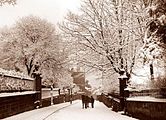| Francis Meadow Sutcliffe | |
|---|---|
 | |
| Born | (1853-10-06)6 October 1853 Headingley, Leeds, England |
| Died | 31 May 1941(1941-05-31) (aged 87) |
| Occupation | Photographer |
| Known for | "Water Rats" |
Francis Meadow (Frank) Sutcliffe (6 October 1853 – 31 May 1941) was an English pioneering photographic artist whose work presented an enduring record of life in the seaside town of Whitby, England, and surrounding areas, in the late Victorian era and early 20th century. His documentation of the Victorian and Edwardian periods in Whitby, led him to be labelled as the "pictorial Boswell of Whitby.
Early life
He was born in Headingley, Leeds, to the painter Thomas Sutcliffe and Sarah Lorentia Button. Frank was the eldest of eight children, and as a child, he slept in his father's studio. He had an elementary education at a dame school before moving into the new technology of photography. His father moved the family to Whitby in 1870 with the hope of commissions, but he died a year later when Francis was 18, leaving him as head of the family.
Career

He made a living as a portrait photographer, working first in Tunbridge Wells, Kent, and then for the rest of his life in Whitby, living in Broomfield Terrace in Whitby before moving to Sleights, Yorkshire. His father had brought him into contact with prominent figures in the world of art such as John Ruskin, and he resented having to prostitute his art taking photographs of holiday-makers. His business in Skinner Street, a converted jet grinding and polishing works, rooted him to Whitby and the Eskdale valley but, by photographing the ordinary people that he knew well, he built up a most complete and revealing picture of a late Victorian town, and the people who lived and worked there.
His most famous photograph was taken in 1886; Water Rats caused a little comment at the time as it featured naked children playing in a boat, but the image is not erotic. Sutcliffe was using the conventions of the academic nude to show how photography can approach art. He was, however, excommunicated by his local clergy for displaying it, as they thought it would 'corrupt' the opposite sex. Edward VII (then the Prince of Wales) later purchased a copy of the picture.
He was a prolific writer on photographic subjects, contributed to several periodicals, and wrote a regular column in the Yorkshire Weekly Post. His work is in the collection of the Whitby Literary and Philosophical Society and in other national collections.
Sutcliffe was a founder member of the Linked Ring Brotherhood (a society that existed to promote photography as an art form), and was made an Honorary Fellow of the Royal Photographic Society in 1941.
At the age of 70, he became the curator of the Whitby Gallery and Museum, he held this post until his death in 1941 at the age of 87.
Personal life
He married Eliza Weatherill Duck, the daughter of a local bootmaker, on 1 January 1875 and had a son and four daughters at his home at High Stakesby Cottages, Ruswarp parish, Whitby. He died at his house Hvid(e)t Huus, Carr Lane, Briggswath, Sleights, aged 87, on 31 May 1941 and was buried in Aislaby churchyard.
Gallery
-
 Portrait of Polly Swallow, 1889
Portrait of Polly Swallow, 1889
-
 Girl on the shore, 1889
Girl on the shore, 1889
-
 Three happy boys, 1889
Three happy boys, 1889
-
 Fisher girl, 1890
Fisher girl, 1890
-
 Whitby, 1890
Whitby, 1890
-
 Three Naked Boys Around a Coble, 1880s
Three Naked Boys Around a Coble, 1880s
-
 Whitby winter
Whitby winter
-
 Whitby, 1890
Whitby, 1890
-
 Farmers Whitby / Dinner Time, c. 1889-91
Farmers Whitby / Dinner Time, c. 1889-91
-
 Whitby, 1890
Whitby, 1890
-
 Farmer people Whitby
Farmer people Whitby
-
 Waterrats, (Sea Urchins), 1886
Waterrats, (Sea Urchins), 1886
-
 Women, c.1890
Women, c.1890
-
 Women, c.1890
Women, c.1890
-
 Fisher people, c. 1898
Fisher people, c. 1898
References
- ^ Hiley, Michael. "Sutcliffe, Francis Meadow ". Oxford Dictionary of National Biography (online ed.). Oxford University Press. doi:10.1093/ref:odnb/38440. (Subscription or UK public library membership required.)
- Hiley 1979, p. 5.
- Barton 2008, p. 1,363.
- Lewis, Stephen (2 April 2017). "A take a snapshot of Victorian seaside life". York Press. Retrieved 23 October 2019.
- ^ Hiley 1979, p. 6.
- Hiley 1979, p. 7.
- Busselle, Michael (1985). "The Story of Photography: Frank Meadow Sutcliffe". Encyclopedia of Photography. Hong Kong: Octopus Books. p. 15. ISBN 0-7064-2373-9.
- "Sutcliffe's winter tale at St Mary's Church". The Whitby Gazette. 18 December 2015. Retrieved 23 October 2019.
- Dhaliwal, Ranjit (25 June 2013). "The Water Rats, 1886". The Guardian. Retrieved 23 October 2019.
- "BBC Inside Out – Inside Out – Yorkshire & Lincolnshire: Monday January 16, Frank Meadow Sutcliffe's Whitby". www.bbc.co.uk. Retrieved 23 October 2019.
- Mead, Harry (31 October 2005). "Portrait of the artist". The Northern Echo. Retrieved 23 October 2019.
- Hirst, Christopher (4 February 2012). "On the waterfront: Frank Meadow Sutcliffe's Whitby". The Independent. Retrieved 23 October 2019.
- Barton 2008, p. 1,364.
- "Sutcliffe: the pioneer in photography". The Whitby Gazette. 5 October 2013. Retrieved 23 October 2019.
Sources
- Barton, Pauline (2008). Hannavy, John (ed.). Encyclopedia of nineteenth-century photography. Vol. 1, A-I, index. London: Routledge. ISBN 978-0-415-97235-2.
- Shaw, Michael (1998). Frank Meadow Sutcliffe - A Fourth Selection. Whitby, North Yorkshire, England: The Sutcliffe Gallery (by agreement with Whitby Literary & Philosophical Society). ISBN 0-9503175-9-4.
- Hiley, Michael (1979). Frank Meadow Sutcliffe. Oxford: Phaidon Press. ISBN 0-89381-041-X.
External links
- Sutcliffe Gallery
- National Museum of Photography, Film & Television gallery of his works 300+ photographs